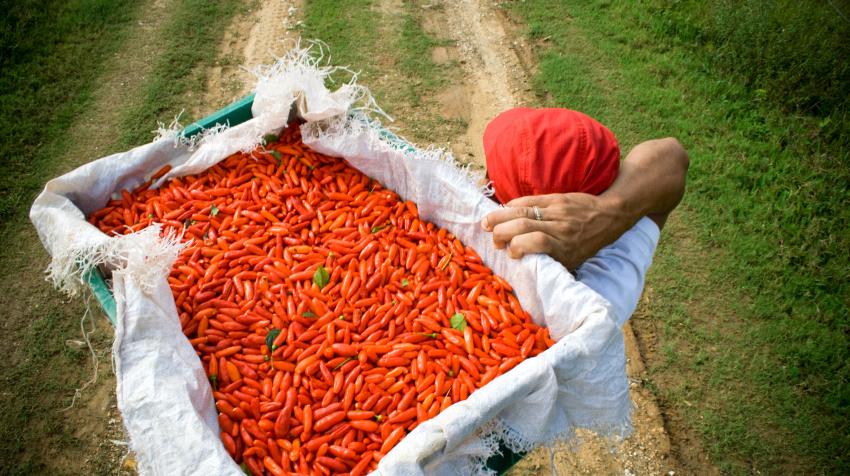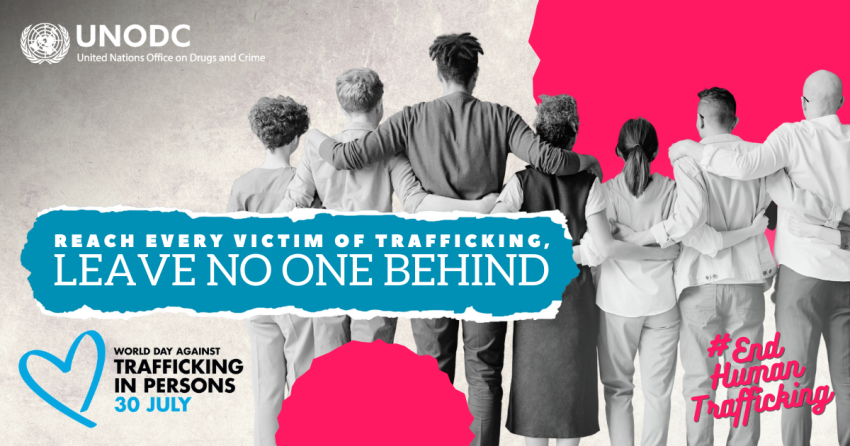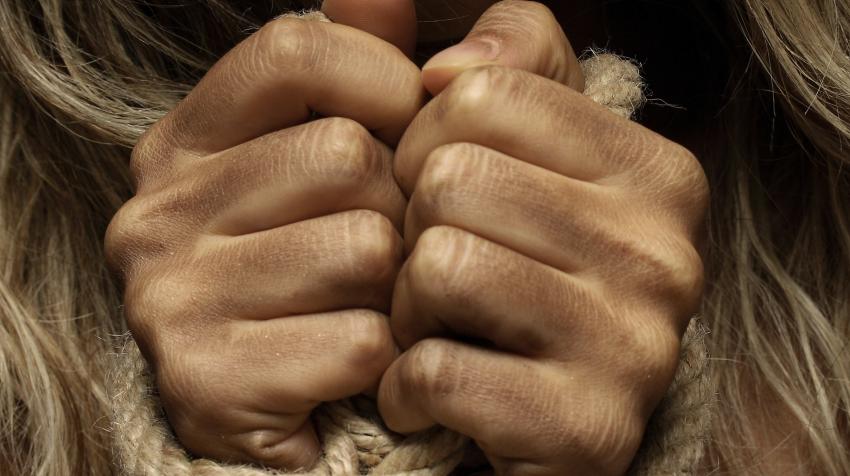24 July 2023
Trafficking in persons remains a pressing global issue. Despite widespread criminalization of this egregious human rights violation and decades of intervention, trafficking in persons and related forms of exploitation—sometimes referred to as modern slavery—are estimated to affect nearly 50 million people on any given day.
While trafficking in persons affects every region of the world, there are some regional trends that can be identified. When it comes to forced labour, there are an estimated 27.6 million people subjected to it at any given time. Asia and the Pacific hosts more than half of them (15.1 million), followed by Europe and Central Asia (4.1 million), Africa (3.8 million), the Americas (3.6 million), and the Arab States (0.9 million). However, this regional ranking changes when forced labour is expressed as a proportion of the population. By this measure, forced labour is highest in the Arab States (5.3 per thousand people), followed by Europe and Central Asia (4.4 per thousand), the Americas, and Asia and the Pacific (both at 3.5 per thousand), and Africa (2.9 per thousand).
It is now clear that certain sectors are disproportionately involved in forced labour. Five sectors—services, manufacturing, construction, agriculture and domestic work—account for nearly 90 per cent of total adults engaged in forced labour. It is also clear that some individuals are more vulnerable to this form of exploitation than others; migrant workers for example, are more than three times more likely to be in forced labour than non-migrant adult workers.
Over the past decade, significant effort has been devoted to better understanding the factors that increase vulnerability or resilience to trafficking to enable more effective, better-targeted prevention efforts.
Trafficking in persons and related forms of exploitation are also deeply gendered. Historically, most identified victims of human trafficking were women, but according to the Counter-Trafficking Data Collaborative, there has been a trend of increasing identification of male trafficked persons in recent years. There are important differences in the forms of exploitation experienced by trafficked men and women, with women much more likely than men to be experiencing forced labour in domestic work, while men are much more likely to trafficked into the construction sector. When it comes to sexual exploitation, the vast majority of people trafficked are women and girls.
New and emerging issues continue to cause vulnerability to trafficking, to facilitate it, or to complicate responses to this problem. War and conflict increase individuals’ vulnerability to trafficking due to displacement, deteriorating rule of law, impunity, social stress and humanitarian need, and social fragmentation and family breakdown. Climate change and environmental degradation strains livelihoods, exacerbates poverty, increases risks of natural disasters, and can drive conflict and instability, all of which can create situations of vulnerability that traffickers exploit. Recruitment and exploitation via online or tech-facilitated means is intensifying, challenging traditional paradigms of identification, referral, protection and assistance to trafficked persons, and of investigations and prosecutions.

The International Organization for Migration (IOM) and the international community have long used what is referred to as the “3P” approach when it comes to addressing trafficking: prevention, protection and prosecution. These are the key elements of response identified in the United Nations Protocol to Prevent, Supress and Punish Trafficking in Persons, Especially Women and Children, which supplements the United Nations Convention against Transnational Organized Crime.
Prevention efforts often focus on public information and awareness-raising, with the aim of ensuring that members of the public are familiar with human trafficking and its disastrous consequences. Such knowledge can enable people to take steps to protect themselves and their loved ones from traffickers; advocate against trafficking in their communities; and make ethical choices in their own consumption, employment and business practices so as to avoid directly or indirectly benefiting from the services of trafficked persons and creating demand for victims.
Over the past decade, significant effort has been devoted to better understanding the factors that increase vulnerability or resilience to trafficking to enable more effective, better-targeted prevention efforts. Evidence collected over the years has shown that there is a range of intersecting factors that increase the risk of being targeted by traffickers. These include poverty, marginalization, financial exclusion, irregular migration status, low educational levels, disability and dysfunctional family environments. Effective responses to these risks go beyond awareness-raising and into development and governance programmes that create more just and equitable societies, which reduces overall vulnerability as well as vulnerability to violence, exploitation and abuse.
Protection work focuses on meeting the needs and protecting the rights of persons who have experienced trafficking in order to support their recovery and restore their capacity to survive and thrive. In the early stages of care, this often means focusing on basic and immediate needs, such as physical safety and security, as well as access to shelter, food and medical care.

Once critical needs are met, intermediate responses focus on supporting trafficked persons in establishing the foundations for successful and sustainable recovery by addressing factors that contributing to their vulnerability. The intermediate responses include improving knowledge of and capacity to claim rights; acquiring skills and competencies for sustainable livelihoods; and counselling, outreach and other assistance for mobilizing social networks and communities to support recovery and reintegration. Long-term protection work aims to help trafficked persons as they acquire and reclaim their roles and responsibilities and achieve economic, social and psychosocial recovery. For internationally trafficked persons, sustainable recovery often involves regularization of migration status, either through local integration, regular onward migration, or return and reintegration.
Finally, prosecution efforts are aimed at building the capacity of law enforcement to investigate and bring to justice those who recruit and exploit trafficked persons for their own gain.
Long-term protection work aims to help trafficked persons as they acquire and reclaim their roles and responsibilities and achieve economic, social and psychosocial recovery.
The Inter-Agency Coordination Group against Trafficking in Persons is mandated by the United Nations General Assembly to improve coordination among United Nations agencies and other relevant international organizations in their efforts to facilitate a holistic and comprehensive approach to preventing and combating trafficking in persons, including protection and support for victims of trafficking.
The Inter-Agency Coordination Group against Trafficking in Persons is itself coordinated by the United Nations Office on Drugs and Crime and is currently co-chaired by IOM and the United Nations Special Representative of the Secretary-General on Violence against Children. The current priorities of this body include setting research standards to enhance the evidence base; addressing drivers of trafficking in persons; sustaining survivor engagement and contributing to survivor empowerment; exploring interlinkages between sudden- and slow-onset climate change-induced disasters and vulnerability to trafficking and exploitation; and strengthening approaches to and understanding of trafficking in persons in crisis contexts.
Overall, the crime of human trafficking remains entrenched in many societies and continues to require deep and sustained efforts to address it. But much progress has been made, including a better understanding of the social, cultural, environmental and political factors that shape trafficking in persons, along with the need to make space for trafficked persons and survivors to take the lead in their recovery and in anti-trafficking work around the globe.
The UN Chronicle is not an official record. It is privileged to host senior United Nations officials as well as distinguished contributors from outside the United Nations system whose views are not necessarily those of the United Nations. Similarly, the boundaries and names shown, and the designations used, in maps or articles do not necessarily imply endorsement or acceptance by the United Nations.




